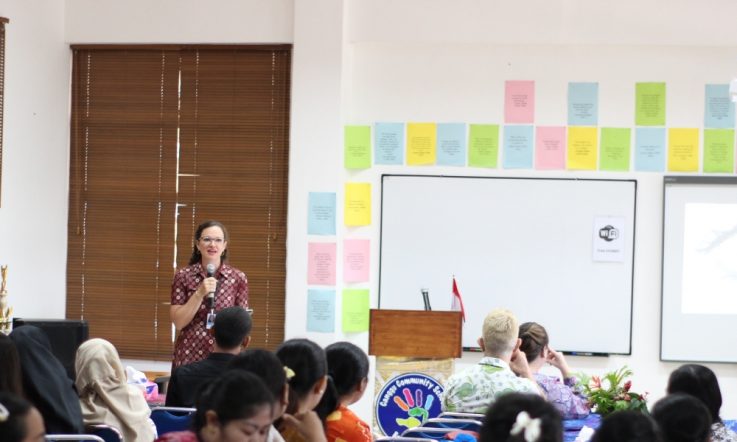Developing the expertise of teaching and catering for the diversity of learners is a key element in improving outcomes for all students.
Research shows that, in the classroom, teachers should be seeking to identify and address the learning needs of individual students. So, should school leaders be thinking along the same lines when it comes to planning staff professional development?
Sarah Verdaguer is a Primary School Principal at Global Jaya School – a K-12 International Baccalaureate (IB) school in Tangerang, Indonesia. She says the school has focused on moving away from a ‘one-size-fits-all' approach to staff professional development.
‘Too many schools have that “let's do PD, all together, in one room” approach, with the idea that “we all need to know this”, she tells Teacher. ‘We are looking at it more from a classroom perspective. When we walk into a classroom, we have different students, different preferences, all sorts of things to consider, but we traditionally have not done the same for teachers' professional development.
‘What we've tried to do within our school over the last few years is to individualise professional development and ensure that our teachers are making the most of their experiences, while still addressing schoolwide initiatives and growth.
‘It is a combination of providing diverse opportunities, encouraging teacher voice and agency, supporting access to a variety of professional development resources and facilitating sessions which create avenues for individualised ‘take-aways' and implementation according to teacher and student needs'.
Verdaguer is joint principal of the K-6 Primary with an Indonesian colleague. There are around 70 teachers, including specialists, and the school operates under a dual language of instruction approach; Indonesian and English. In the classroom, expatriate and Indonesian teachers work as a team and are responsible for student learning together.
As with any school, there's a range of expertise, experience and developmental needs among Global Jaya staff. ‘… So, it is vital that we are aware of where people are coming from and how best they might access information and apply it in their own classroom. We put ourselves in the shoes of the people we're trying to develop.'
The school has introduced a structure to guide professional growth and development. Verdaguer says the core objective is to improve student outcomes. ‘For us, that was the main focus – how can we make sure that our professional development is actually having an impact?'
The program is informed by the school's Strategic Action Plan and teacher feedback, and centres around eight professional standards, seven of which came from James Stronge's work on teacher evaluation and development. ‘The standards range from professional knowledge and assessment for/of learning to instructional reflection and student progress.'
In Term 1, Verdaguer distributes a Google Doc to teachers which includes the professional standards, suggestions for how they might want to target their professional development (which takes into account the strategic priorities), and options for support and resources they may need. Teachers then put together an individual action plan.
‘They might request a mentor or a coaching sort of relationship, or access information and resources from a variety of different sources, including those within the school community or online – they have options as to where and how they want to complete the process. They are also assigned a PD Buddy, so they can come together to discuss their ideas, reflect on where they're up to and where they would like to go next. Their buddy might make some suggestions, maybe identify somebody that they should work with, or go and observe teaching, or share a relevant resource … those types of things.'
Time is built into teachers' schedules every three weeks to work on professional growth and development. That may mean working independently, collaborating, using the time to observe a colleague or reflecting on progress or setting up something they're wanting to implement in the classroom as a result of what they have learned.
‘It does give the teachers a lot of autonomy in what they're doing, but also accountability and responsibility going forward as well,' Verdaguer explains. ‘That's an expectation as a teacher at Global Jaya, you must develop professionally, and we find that they really engage with the process. It's a big part of what they do because they have a say over what they focus on and how they go about it.'
She says there are lots of PD options available to staff, including IB workshops throughout the Asia Pacific region, conferences, involvement in the Indonesian IB learning community, IB Dunia (which runs a teachers' conference), and in-house PD that utilises leadership and subject-specific expertise. Staff can also collaborate through their intranet connections, Google Drives, and a teachers' board where they can share their thoughts and ideas on a monthly theme.
‘We've got many different types of professional development opportunities in place – anything creative. And flexibility to suit a teacher's schedule and commitments. We do a lot of sharing … whether it's an article, an infographic, or whatever it might be. Whether you're an assistant teacher or a principal, everybody, if you see something share it. It is not really a structure, it's part of our school culture, I suppose, it is how we dive into professional development.'
During Term 3, teachers reflect on their action plan progress and talk with their PD buddy, then present to year level colleagues about what they've learned and how it has impacted student learning. At the end of Term 3, teachers identify two specific areas they'd like to target for professional development in the following school year.
‘What we've actually found is, the more individualised our approach, the more teachers are engaged with the process and the more they actually go beyond expectations, ensuring an even greater impact on student learning.'
As a school leader, how do you assess the professional development needs of staff? Are professional development programs at your school linked to strategic priorities?
Think about your own professional development in the last 12 months. What impact has it had on your classroom practice? What impact has it had on student outcomes?

